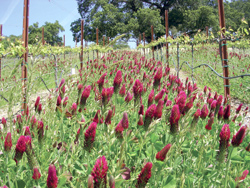
Farm Feature: A Toast to Ecological Grape Production
- Uses cover crops to enhance beneficials and restrain plant vigor
- Manages riparian vegetation to reduce pests
- Matches flowers to resource needs of beneficials
Few wine drinkers are in the market for Cabernet Sauvignon with hints of asparagus or green pepper — herbaceous or “green” characters prompted by overly vigorous vines. Fewer still want utterly tasteless wines that have been drained of their flavors by spider mites.
In the vineyards of California’s North Coast, consultant Zach Berkowitz’s clients know that their wines will inevitably tell the tale of how their grapes were grown. During his three decades of advising grape growers, Berkowitz has learned that some pest management methods favor flavor while others put it at risk.
Berkowitz, who calls himself a “first-generation farmer,” earned a degree in plant science from the University of California-Davis in 1980. Long committed to sustainable production, he says what he learned there about integrated pest management “immediately struck a chord.” Now working with 10 or more growers and 1,500 or more acres — mostly in Napa and Sonoma counties — he tries to encourage beneficial organisms to keep production systems in balance while he manages for superior wine quality.
Start with cover crops
At the very least, Berkowitz says all grape growers can sow a no-till cover crop in the highly trafficked “avenues” surrounding their vineyards. “If those areas are seeded and mowed, that helps keep down dust, which helps keep down mites.”
He also advises his clients to plant either annual or perennial cover crops in their vineyard rows — preferably between mid-September and mid-October. For vineyards whose soil is shallow or whose vines aren’t strong, he recommends an annual mix of ‘Zorro’ fescue, ‘Blando’ brome and clovers. For those on flatter ground and with stronger vines, he prefers blends of such native perennial grasses as California brome, meadow barley and blue wildrye.
By curbing the vines’ excessive vigor, these cover crops boost the grapes’ appeal to wine drinkers and diminish their palatability to western grape leafhoppers. Berkowitz suspects that cover crops — especially “insectary” blends of flowering plants — also intensify populations of spiders, lacewings and other natural enemies of leafhoppers, thrips and mites.
“It’s kind of a subtle effect, but I think that over time the advantage increases,” says Berkowitz. “You get that natural balance happening and it seems like your pest problems decrease.”
Densely forested creeks surround many North Coast vineyards. “We’re not cultivating fenceline to fenceline; we’re striving to avoid monoculture,” Berkowitz says. There’s “reason to believe” this additional biodiversity contributes to pest control, he says, but more research would help.
Patience pays
Berkowitz says he likes to “preach patience,” especially in managing fall-planted annual cover-crop mixes. “People want to mow it so it looks nice and tidy, but it’s best to just let it go to seed,” he says. By delaying mowing until April or May, growers can watch their thick layer of thatch turn golden brown in summer, then germinate naturally with the fall rains.
He makes an exception if the annual cover crop is infested with tall-growing mustards or other “junky resident weeds.” Then, growers should mow first in January or February before those weeds set seed, setting their blades high enough to safely clear the crop. Repeated over several years, this process eventually creates the right conditions for the cover crop to dominate and the weeds to “kind of go away.”
By late spring, when his clients mow their perennial grass-legume mixes, those cover crops have also served as alternate hosts for natural enemies. Berkowitz’s experience indicates that, in the long term, even grass cover crops trim populations of leafhoppers, though not necessarily below economic thresholds.
Sow and mow strategically
Some growers like to cultivate every other row of their cover crops in early April and mow the rows in between. Then, they disk the mowed rows in May. To Berkowitz, that’s better for pest management than mowing too early and almost as good as allowing the covers to go entirely to seed.
Other growers — not ready for a solid floor of no-till cover crops — don’t plant those alternate rows to begin with. Instead, they simply sow every other row. Berkowitz endorses that practice for sites where soils aren’t rich or deep and vines aren’t overly vigorous. “It gives producers a little bit of a compromise and over time they can go to complete no-till.”
Berkowitz cautions growers not to overfertilize insectary blends, whose energy should go towards flowering rather than towards vegetative growth, and he advises against fertilizing grass-legume mixtures at all, since the legumes will eventually help supply nitrogen. He supports fertilizing solely when growers of grass-only covers want “quick, thick” stands for erosion control.
Manage flexibly and responsively
On the rare occasions that leafhoppers or thrips exceed economic thresholds in his clients’ vineyards, Berkowitz recommends insecticides. “We try to use systems that control pests without chemicals, but sometimes you’re just stuck.”
That’s often the case with Pierce’s disease, whose damage can force frequent replanting. Berkowitz says insecticide treatment for the blue-green sharpshooter during the first hot spells can regulate this vector’s early movement into vineyards. Another approach showing “some merit” is riparian vegetation management: replacing host plants with non-hosts. This reduces the sharpshooter’s populations while broadening diversity. “Today we try to manage the vector, but someday we hope to be able to control the disease itself,” he says.
Over the years, Berkowitz has learned not to include ‘Berber’ orchard grass or annual ryegrass in cover crop mixtures because they’re simply too competitive with grapevines. He has also observed that using sulfur to organically control powdery mildew kills predaceous beneficial mites faster than its kills prey mites.
“You think you’re doing a good thing by dusting with sulfur, but at the end of the season you wind up with these mite problems.” In vineyards where this has occurred, Berkowitz advises producers to substitute non-sulfur controls like biofungicides after early-spring treatments with sulfur. He has watched that strategy “really help” in repeatedly mite-infested vineyards.
“It’s a systems approach,” says Berkowitz. “That’s what makes sustainable agriculture interesting to me: everything is connected.”
